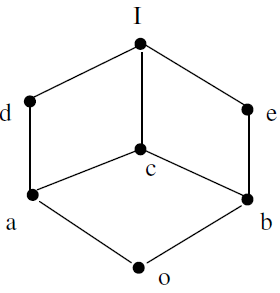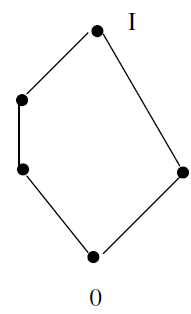SKEDSOFT
Example: Is the following lattice a distributive lattice ?

Solution: The given lattice is not distributive since {0, a, d, e, I} is a sublattice which is isomorphic to the five-element lattice shown below :

Theorem: Every chain is a distributive lattice.
Proof: Let (L, ≤) be a chain and a, b, c ∈ L. We shall show that distributive law holds for any a, b, c ∈ L. Two cases arise :
Case 1. Let a ≤ b or a ≤ c. In this case
a ∧ (b ∨ c) = a
and
(a ∧ b) ∨ (a∧ c) = a
and hence
a ∧ (b ∨ c) = (a ∧ b) ∨ ( a ∧ c)
Also, by Principle of Duality
a ∧ (b ∨ c) = (a ∨ b) ∧ (a ∨ c)
Case II. Let b ≤ a or c ≤ a . Then we have
a ∧ (b ∨ c) = (b ∨ c)
and
(a ∧ b) ∨ ( a ∧ c) = (b ∨ c)
Hence
a ∧ (b ∨ c) = (b ∨ c)
Hence distributive law holds for any a, b, c ∈ L.
Theorem: The direct product of any two distributive lattices is a distributive lattice.
Proof: Let (L1, ≤1) and (L2, ≤2) be two lattices in which meet and join are ∧ 1, ∨ 1 and ∧ 2, ∨ 2 respectively. Then meet and join in L1 X L2 are defined by
(a1, b1) ∧ (a2, b2) = (a1 ∧1 a2, b1 ∧ 2 b2).............. (1)
and
(a1, b1) ∨ (a2, b2) = (a1 ∨1 a2, b1 ∨ 2 b2)..................... (2)
Since L1 is distributive,
a1 ∧1 (a2 ∨1 a3) = (a1 ∧1 a2) ∨1 (a1 ∧1 a3)...................... (3)
Since L2 is distributive,
b1 ∧2 (b2 ∨2 b3) = (b1 ∧2 b2) ∨2 (b1 ∧2 b3)............................ (4)
Therefore
(a1, b1) ∧ [(a2, b2) ∨ (a3, b3)]
= (a1, b1) ∧ [(a2 ∨1 a3, b2 ∨2 b3)]
= [(a1 ∧1 (a2 ∨1 a3), b1 ∧2 (b2 ∨2 b3)]
= [(a1 ∧1 a2) ∨1 (a1 ∧1 a3), (b1 ∧2 b2) ∨2 (b1 ∧2 b3)]
(using (3) and (4))
and using (1) and (2), we have
[(a1, b1) ∧ (a2 , b2) ] ∨ [((a1, b1) ∧ (a3 , b3)]
= (a1 ∧1 a2, b1 ∨2 b2) Ú (a1 ∧1 a3, b1 ∧2 b3)
= [(a1 ∧1 a2) ∨1 (a1 ∧1 a3), (b1 ∧2 b2) ∨2 (b1 ∧2 b3)]
Hence
(a1, b1)∧ [(a2, b2)∨ (a3, b3)] = [(a1, b1)∧ (a2 , b2) ]∨ [((a1, b1)∧ (a3 , b3)], proving that L1 X L2 is distributive.